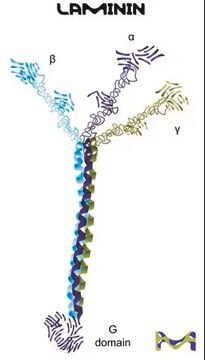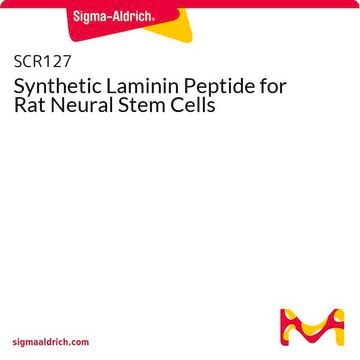L6274
Laminin from human placenta
liquid, BioReagent, suitable for cell culture
Synonym(s):
Cell culture grade laminin, Human Laminin
Sign Into View Organizational & Contract Pricing
All Photos(2)
About This Item
Recommended Products
biological source
human placenta
Quality Level
product line
BioReagent
form
liquid
concentration
0.5 mg/mL in Tris-buffered saline
technique(s)
cell culture | mammalian: suitable
surface coverage
1‑2 μg/cm2
UniProt accession no.
shipped in
dry ice
storage temp.
−70°C
Gene Information
human ... LAMB1(3912)
Application
Laminin supports growth and differentiation of many cell types including epithelial, endothelial, neural, muscle and liver cells. It is recommended for use as a cell culture substratum at 1-2 μg/cm2. The optimal concentration does depend on cell type as well as the application or research objectives.
Biochem/physiol Actions
Laminin proteins are integral components of structural scaffolding in animal tissues. They associate with type IV collagen via entactin and perlecan and bind to cell membranes through integrin receptors, dystroglycan glycoprotein complexes and Lutheran blood group glycoproteins. Laminin has active domains for collagen binding, cell adhesion, heparin binding, and neurite outgrowth fragment.
Components
Laminin is an extracellular matrix multidomain trimeric glycoprotein, and is the main non-collagenous component of basal lamina that supports adhesion, proliferation and differentiation. Laminin is composed of both A, B1 and B2 chains, which are connected by many disulfide bonds. This laminin product is purified from human placenta using pepsin treatment and immunoaffinity chromatography. SDS-PAGE results in two major bands at 50 kDa and 130-160 kDa.
Caution
It is recommended to store this product at -70°C, where it will remain stable for two years.
Preparation Note
This product is supplied at a concentration of 0.5 mg/mL in 50 mM Tris-HCl, with 150 mM NaCl. It is 0.2 μm filtered. Thaw this solution slowly before use at 2-8°C to avoid gel formation. For use as a coating, dilute in a sterile balanced salt solution, coat culture surface with a minimal volume and incubate at 37°C for two hours. Wash 3 times with PBS before plating cells. Laminin coatings can be stored for one month at 2-8°C.
Storage Class Code
10 - Combustible liquids
WGK
WGK 3
Flash Point(F)
Not applicable
Flash Point(C)
Not applicable
Choose from one of the most recent versions:
Already Own This Product?
Find documentation for the products that you have recently purchased in the Document Library.
Customers Also Viewed
Satu Marja Myllymäki et al.
PloS one, 6(5), e19453-e19453 (2011-05-17)
Formation of apical compartments underlies the morphogenesis of most epithelial organs during development. The extracellular matrix (ECM), particularly the basement membrane (BM), plays an important role in orienting the apico-basal polarity and thereby the positioning of apical lumens. Integrins have
Sandhanakrishnan Cattavarayane et al.
BMC cell biology, 16, 3-3 (2015-04-19)
The growth properties and self-renewal capacity of embryonic stem (ES) cells are regulated by their immediate microenvironment such as the extracellular matrix (ECM). Integrins, a central family of cellular ECM receptors, have been implicated in these processes but their specific
Vivek K Vishnudas et al.
Human molecular genetics, 18(23), 4467-4477 (2009-08-21)
The severely debilitating disease Congenital Muscular Dystrophy Type 1A (MDC1A) is caused by mutations in the gene encoding laminin-alpha2. Bax-mediated muscle cell death is a significant contributor to the severe neuromuscular pathology seen in the Lama2-null mouse model of MDC1A.
Danielle K Lewis et al.
Aging cell, 7(6), 836-849 (2008-09-10)
Astrocytes comprise a large proportion of the central nervous system support cells and play a critical role in neural injury and repair. The present study examined the impact of ovarian aging using an ex vivo model system, where astrocytes were
Terhi P Teräväinen et al.
PloS one, 8(8), e71485-e71485 (2013-08-27)
The properties of epithelial cells within tissues are regulated by their immediate microenvironment, which consists of neighboring cells and the extracellular matrix (ECM). Integrin heterodimers orchestrate dynamic assembly and disassembly of cell-ECM connections and thereby convey biochemical and mechanical information
Articles
Cancer stem cell media, spheroid plates and cancer stem cell markers to culture and characterize CSC populations.
Our team of scientists has experience in all areas of research including Life Science, Material Science, Chemical Synthesis, Chromatography, Analytical and many others.
Contact Technical Service











